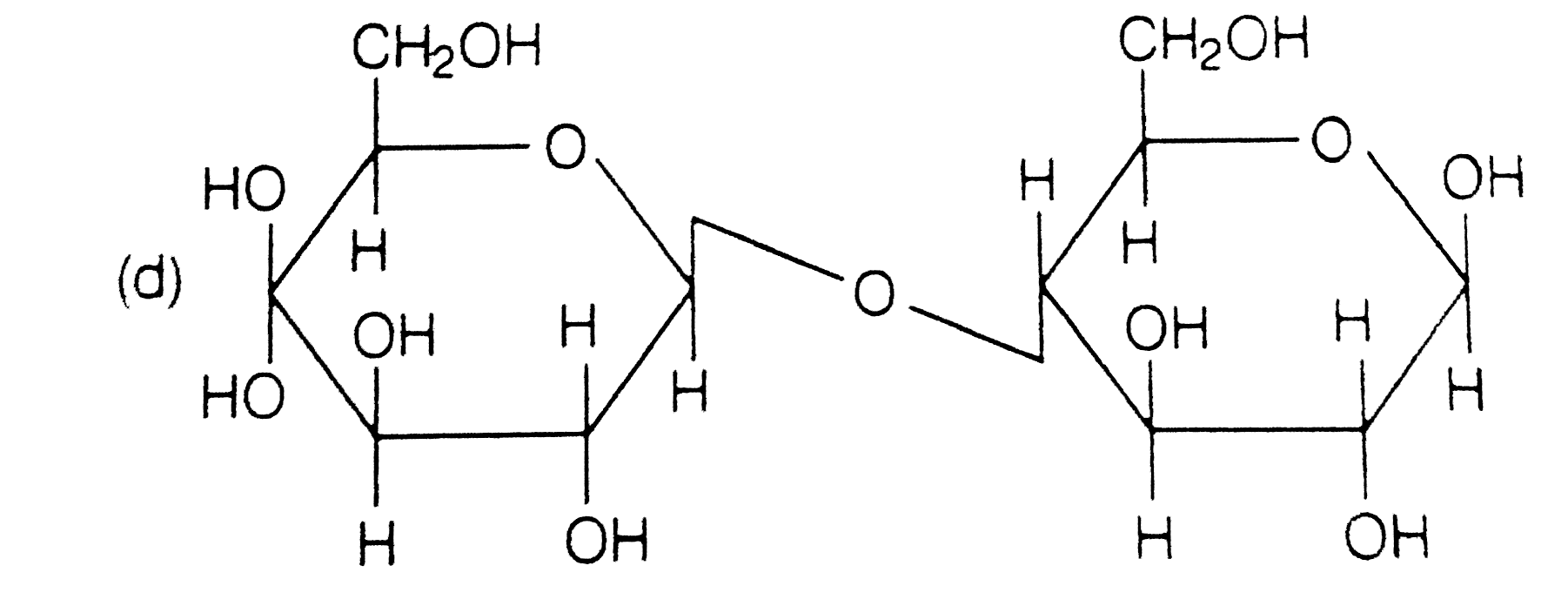Disaccharides that are reducing in nature are:
sucrose and lactose
sucrose and maltose
lactose and maltose
sucrose, lactose and maltose
The correct Answer is:C
To determine which disaccharides are reducing in nature, we need to analyze the structures of the given disaccharides: sucrose, lactose, and maltose.
1. Understanding Reducing Sugars:
- Reducing sugars are those that can act as reducing agents. They contain a free aldehyde or ketone group that can be oxidized, while they reduce another substance in the process.
2. Analyzing Sucrose:
- Sucrose is composed of glucose and fructose. The linkage between them is a glycosidic bond that involves the anomeric carbon of both sugars.
- In sucrose, both the anomeric carbons are involved in the glycosidic bond, meaning there is no free aldehyde or ketone group available.
- Therefore, sucrose is not a reducing sugar.
3. Analyzing Maltose:
- Maltose is made up of two glucose units. The structure of maltose has one of the glucose units with a free anomeric carbon (hemiacetal) because it is linked to the other glucose unit through the anomeric carbon of one glucose.
- This free anomeric carbon allows maltose to have a free aldehyde group, making it a reducing sugar.
4. Analyzing Lactose:
- Lactose consists of one glucose and one galactose unit. Similar to maltose, lactose has a free anomeric carbon on one of the units (either glucose or galactose).
- This free anomeric carbon allows lactose to also have a free aldehyde group, making it a reducing sugar.
Conclusion:
- Among the disaccharides mentioned, lactose and maltose are reducing sugars, while sucrose is not.
- Reducing sugars are those that can act as reducing agents. They contain a free aldehyde or ketone group that can be oxidized, while they reduce another substance in the process.
- Sucrose is composed of glucose and fructose. The linkage between them is a glycosidic bond that involves the anomeric carbon of both sugars.
- In sucrose, both the anomeric carbons are involved in the glycosidic bond, meaning there is no free aldehyde or ketone group available.
- Therefore, sucrose is not a reducing sugar.
- Maltose is made up of two glucose units. The structure of maltose has one of the glucose units with a free anomeric carbon (hemiacetal) because it is linked to the other glucose unit through the anomeric carbon of one glucose.
- This free anomeric carbon allows maltose to have a free aldehyde group, making it a reducing sugar.
- Lactose consists of one glucose and one galactose unit. Similar to maltose, lactose has a free anomeric carbon on one of the units (either glucose or galactose).
- This free anomeric carbon allows lactose to also have a free aldehyde group, making it a reducing sugar.
- Among the disaccharides mentioned, lactose and maltose are reducing sugars, while sucrose is not.
Topper's Solved these Questions
- SAMPLE QUESTION PAPER (CHEMISTRY )BOOK - CBSE MODEL PAPERCHAPTER - SAMPLE QUESTION PAPER (CHEMISTRY )EXERCISE - SECTION A (OBJECTIVE TYPE) ASSERTION REASON
11 Videos
- SAMPLE QUESTION PAPER (CHEMISTRY )BOOK - CBSE MODEL PAPERCHAPTER - SAMPLE QUESTION PAPER (CHEMISTRY )EXERCISE - SECTION B
13 Videos
- SAMPLE PAPER 2023 TERM IBOOK - CBSE MODEL PAPERCHAPTER - SAMPLE PAPER 2023 TERM IEXERCISE - SECTION E
7 Videos
Similar Questions
Why sulphurous acid and sulphites are reducing in nature.
View SolutionDisaccharides - Sucrose|Disaccharides - Maltose|Disaccharides - Lactose|Reducing Sugars And Non-Reducing Sugar|Disaccharides|Structure Of Starch (C6H10O5)n|Structure Of Cellulose (C6H10O5)n|Glycogen|Importance Of Carbohydrates|OMR
View Solution
Knowledge Check
Disaccharides that are reducing in nature are:
Asucrose and lactoseBsucrose and maltoseClactose and maltoseDsucrose, lactose and maltoseWhich of the following disaccharide is not a reducing sugar?
AMaltoseBLactoseCSucroseDBoth (1) and (2)In disaccharides, if the reducing groups of monosaccharides, i.e., aldehydic or ketonic groups are bonded, these are non-reducing sugars. Which of the following disaccharide is a non-reducing sugar?
A B
B C
C D
D
Classical smog is reducing in nature.
View SolutionThe two monosaccharides are joined together by an oxide linkage formed by the loss of a water molecule. Such a linkage between two monosaccharide units through oxygen atom is called glycosidic linkage. In disaccharides, if the reducing groups of monosaccharides i.e., aldehydic or ketonic groups are bonded, these are non-reducing sugars, e.g., sucrose. On the other hand, sugars in which these functional groups are free, are called reducing sugars, for example, maltose and lactose. A non reducing disaccharide 'A on hydrolysis with dilute acid gives an equimolar mixture of D-(+)glucose and D-(+)-Fructose.

Name the linkage that holds the two units in the disaccharide?
View SolutionIn disaccharides, if the reducing groups of monosaccharides, i.e., aldehydic or ketonic groups are bonded, these are non-reducing sugars. Which of the following disaccharide is a non-reducing sugar?
View SolutionIn disaccharides, if the reducing groups of monosaccharides, i.e., aldehydic or ketonic groups are bonded, these are non-reducing sugars. Which of the following disaccharide is a non-reducing sugar?
View SolutionIn disaccharides, if reducing groups of monosaccharides i.e. aldehydic or ketonic groups are bonded, these are non-reducing sugars. Which of the following disaccharides is a non-reducing sugar ?
View Solution
